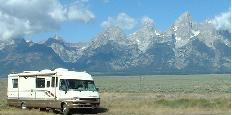The term “Boondocking” means different things to different RV campers. Dry camping, dispersed camping, and any time RV hookups are not available parking have been refered to as “Boondocking”.
www.rv-camping.org defines Boondocking as remote location RV camping. With this in mind, you might call boondocking advanced RV camping. This type of RV camping isn’t for everyone. RV camping in remote areas requires research, exploration, and a sense of adventure to find great RV campsites.
Not sure if you’re ready for boondocking? The Boondocking Basics book will provide you information about living without hookups in your RV, and other related boondocking information for beginners.
Boondocking Locations
Generally speaking, boondocking is allowed anywhere on federal public lands within 300 feet of any estabilished road, except where otherwise restricted. That’s not to say that you can cut down trees or build a new access way into your RV campsite. The idea is to utilize previously used campsites, or areas that will not be damaged by your vehicles access to the campsite.
US National Parks do not allow overnight RV parking and boondocking, and overnight stays are limited to designated campgrounds. USFS (United States Forest Service) and BLM (Bureau of Land Management) high popularity areas often have restricted camping areas. For example, the area around Mammoth Lakes, CA is extremely popular with tourists, and many areas allow camping only in designated campgrounds. Information about camping restrictions are available at USFS Ranger District and BLM Resource Area offices.
Generally speaking, you can stay 14 continuous days for free, but subsequent camping days must be 25 miles away. This rule applies to most BLM and USFS administered lands, but there are exceptions. For example, the INYO National Forest of California allows 42 day stays at designated camping areas, while the Bridger-Teton National Forest in Wyoming has areas that it allows only 3 day stays near Grand Teton National Park. BLM LTVAs (Long Term Visitor Areas) allow stays of several months for a nominal fee.
We’ve only mentioned the USFS and BLM so far, but FWS (US Fish & Wildlife Service), ACE (Army Corps of Engineers), Bureau of Reclamation, State Parks, and State owned lands offer boondocking opportunities. Arizona for example has a permit available for a nominal fee allowing boondocking on State lands.
There are also boondocking opportunities to be found on private lands. Ranches and farms may have a corner of the “back 40” they will allow you to stay for free or small fee. If you find a spot you would like to camp that is on private land, it never hurts to ask. We’ve had good success in farm country asking permission to camp at nice areas near a river with good access for overnight boondocking…we usually share the space with cows.
How To Find Great Boondocking Sites
So now that you know that you can set up camp just about anywhere in the forest, how do you go about finding a great RV camping/boondocking site? This is where the work starts, but the harder you work at it, the better the RV campsite you’ll find. If you live near the public lands area you wish to camp in, your task is easier as you can explore more frequently and learn the area completely. For those of us that travel and want to find great boondocking sites, we’ve found that doing our homework before we get to a new area will always pay off with a great boondocking site.
RV type and size changes where you boondock. Pop up and truck campers have a distinct advantage for getting to really remote RV camping sites. When you have a large 5th wheel or motorhome, boondocking seems more difficult, but with just a little practice, you will soon determine how to explore effectively to accomodate your rig.
The easiest way of finding RV boondocking sites in a new area requires that you:
- Have maps and navigational information
- Contact Public Lands administrators for the area being visited
- Locate a “base” campground
Exploration After determining a general location you wish to boondock, it’s time examine some general information. USFS – United States Forest Service, BLM – Bureau of Land Management, and other State and US Government departments have Internet web sites with recreation information. Getting official travel maps of a new area can help in finding a good RV camping site. Topographical maps are in our opinion the best way to determine where we want to camp. While we prefer National Geographic shaded relief Topo maps, MapTech is our choice for online topo mapping information. Examine the Topo map for areas that look interesting for your type of RV camping. It won’t take long to find areas that look interesting to you.
The areas you find with your Topo map can further be researched by contacting the local public lands administrators. Ask about dispersed camping in the area you are interested in. You may or may not get the answers you need. Some of the folks providing information may not be aware of some great RV camping sites. Get information about designated campgrounds and if reservations are required.
Armed with the campground information, locate one near where you think you want to boondock. This campground will be your “base” camp to explore for that perfect RV boondocking site. You will often find a great RV camping site on the way to the designated campground, which eliminates the need for exploration, but always plan on needing to find your own RV camping site.
Exploring can be fun, but it’s also frustrating from time to time. Our frustrations always come from finding great RV camping sites that don’t offer a clear view of the southern sky for our satellite internet connection. Most folks won’t have that as an issue, and will easily find boondocking sites. The size of your RV is a major consideration when heading into remote areas, and be sure to consider potential weather changes and how they might effect road conditions where you want to camp.
Advanced RV Camping
Once you find that terrific RV boondocking site, it’s time to settle in and enjoy the area. Conserving your resources is the key to enjoyable boondocking. Leave No Trace camping principles should be your guide to help protect our RV camping resources for future generations. Boondocking offers the RVer the most options for outdoor recreation, but the responsibility of good stewardship towards the land is in your hands. You wouldn’t want to find a great RV boondocking site that has trash and human and pet waste all over the area, and you shouldn’t leave your site that way either. Always leave your RV camping site better than you found it.
Here are a few tips to extend your resources:
Battery charge can be extended by turning off your furnace/heater at night and adding a blanket or two to the bed. Turn off lights when not needed. Minimize use of TV and other electric power appliances. Florescent lights use less energy. Solar power and an inverter can set you free electrically. Generators are popular for extending RV camping trips too, but try and limit their useage to battery charging.
Extend your RV propane supply by turning off your water heater and only use it when needed. Adding that extra blanket to your bed will save propane too. Put on a sweater or jacket instead of turning up the heat.
Water…It seems you can never have enough. Carry extra water containers if you can. Take very short “military” showers. Wash dishes once a day after wiping dirty dishes off with paper towels. Wash dishes in a dishpan. Use disposable dishes, cups, and eating utensils. An electric transfer pump can move water from containers into your RVs fresh tank easily. Using an old milk jug filled with water for flushing is much more water efficient than letting your RVs toilet do the job.
Bears poop in the woods, and you can too. As long as you are well away from water, digging a “cathole” is perfectly acceptable, and part of the Leave No Trace camping principles mentioned above.
Your dirty dish water can be dispersed as long as you are well away from water sources. Don’t dump it in the same place all the time as flys will become a problem. Some folks use their dish water for flushing purposes.
Other Boondocking Resources
Boondocking locations can be found on the Internet on RV forums and newsgroups. Local chamber of commerce offices and visitor centers are good places to inquire at too. Talking to other RVers is one of the best ways to find new places, but be aware that many people don’t want to share their favorite RV camping and boondocking sites. Free camping guides may point you towards some great boondocking sites, and our Free Camping Section has some wonderful boondocking spots as well.
Finding great RV camping and boondocking sites can be a bit of work, but with some research and exploration, you should find exactly what you are looking for. www.rv-camping.org

